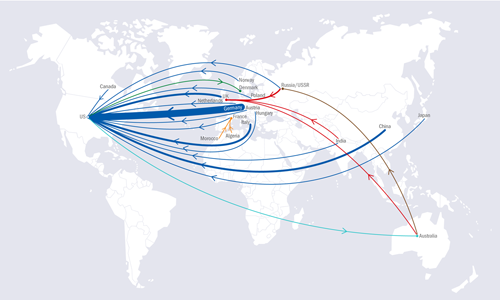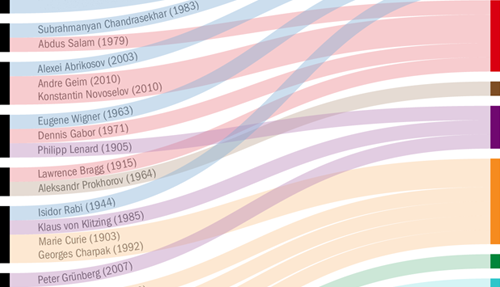
Migration of minds: maps showing the movement of Nobel laureates (click to see full infographic). (Design: Paul Matson)
By Hamish Johnston
Next Tuesday the Nobel Prize for Physics will be announced at 11:45 CEST and I am making the bold prediction that the winner – or one of the winners – will be an immigrant. Why? Because this year’s Physics World Nobel-prize infographics show that of the 198 people who have won the prize, 51 are immigrants – so I reckon there is a reasonable chance that I will be right.
What do we mean by an immigrant? This is a tough question, especially in science, where people tend to move around a lot and don’t always settle in one place. For the purposes of these infographics, we have used a rather crude definition of an immigrant laureate: someone who died or currently lives in a country other than that of their birth. There is more about how we made the infographics later in this post – but first, what do they tell us?
The first infographic (above) paints a geographical picture of migration, with the thickness of the arrowed lines showing the numbers of laureates who have migrated from one country to another. The most glaring fact is that the US is the clear winner when it comes to inward migration. The country has attracted 30 of these top physicists and only lost two. Another striking observation is the brain drain from Germany, which has lost 13 physicists – 11 of whom went to the US. While the rise of Nazism in Germany accounts for much of this migration, it is interesting to note that the last three Germans to go to the US – Horst Störmer, Herbert Kroemer and Wolfgang Ketterle – arrived long after the Second World War.
All the numbers and the names of our immigrant laureates are shown in the second infographic below. It offers a different perspective on migration with a focus on the receiving nations, which appear on the right.

Winners and losers: the US has gained 30 laureates while Germany has lost 13 (click to see full infographic). (Design: Paul Matson)
Second place in terms of influx is France, which has been very good at attracting talent from its French-speaking neighbours. The UK has also come out a net winner, gaining laureates from its former colonies as well as Eastern Europe. The latest newcomers are USSR-born Andre Geim and Konstantin Novoselov, who bagged the 2010 prize for isolating graphene.
While we think these infographics do a good job of capturing migration patterns of Nobel winners, they are not perfect. Indeed, when compiling the data we often struggled with whom to include as an immigrant. For example, the 2009 laureate Willard Boyle was born in Canada, did his prize-winning research in the US, but then returned to Canada, where he enjoyed a long retirement before his death in 2011. As a result, we did not count Boyle as an immigrant, although some might argue that he was an immigrant when he did his Nobel-winning work. However, adopting that criterion introduces another problem. Enrico Fermi – who left Italy for the US shortly after winning his prize – would then not be counted as an immigrant, despite the important contributions he subsequently made to physics in his adopted American homeland.
Shifting borders also posed a challenge when compiling and presenting these data. Some parts of Europe have changed countries three of four times during the 20th century, throwing up some strange instances. One of the trickiest calls was Alfred Kastler, who was born in Alsace in 1902. It was then part of Germany but became part of France in 1918. Kastler pursued his career in France, where he died in 1984, and despite his Germanic surname and apparent penchant for writing poetry in German, we did not include him as an immigrant.
We’ve done our best to navigate through the shifting borders of Europe (and the Indian subcontinent), but if you disagree with any of our data or think we have forgotten someone, please let us know.
Maybe it would be necessary to share it with Donald Trump.
Greetings from México.
It is the “modern migration” map, though the movement and migration of savants of all sorts for differnt reasons has been a historic.
Trackback: Blog - physicsworld.com
Trackback: » Laureates on the move
Trackback: » More on migration
Trackback: And the winner is: our 2015 Nobel-prize predictions – MyPhysNet
Trackback: New infographics show that more than one-quarter of physics Nobel laureates are immigrants – MyPhysNet
Trackback: Blog - physicsworld.com
Trackback: Blog - physicsworld.com